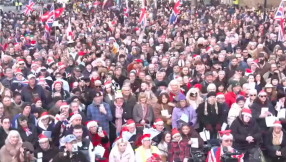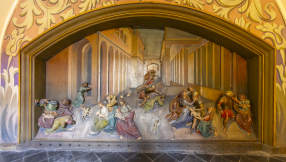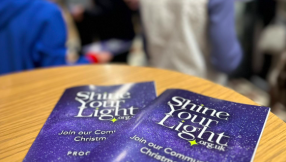The Process of Electing the New Pope
The process of electing a new Pope has begun, and the process is a centuries-old process. Over the next 2-3 weeks certain rituals will take place and a successor to Pope John Paul II will be chosen by the Roman Catholic Electing Cardinals.
Basically the process will involve 5 steps:
1) Roman Catholic Electing Cardinals Make their way to Rome upon the death of Pope John Paul II
2) A Secret Conclave is held
3) A Special series of Voting Rituals will be carried out
4) A decision will be agreed between the Cardinals
5) The new Pope will be announced to the Roman Catholic people and the world
1) Cardinals go to Rome
The “College of Cardinals” will gather in Rome upon the death of the Pope, and a closed-door meeting will take place in a ritual named the ‘Conclave’.
The secret Conclave will take place in the Sistine Chapel, and here they will be able to vote in a top secret environment.
However, the Conclave will not commence until between 15-20 days have elapsed since the Pope’s death. Traditionally this period was put in place to allow Cardinals to be summoned and give them time to make their long journeys to Italy’s capital city. Although the reasoning behind this time lapse has been made inept by the advances in modern-day travel, the tradition is still respected and heeded to.
The funeral rites are celebrated for nine days with a funeral occurring 4-6 days after the announcement of the death. At this time the Cardinals will take charge of the day to day running of the Vatican, and the vital Cardinal at this stage will be the ‘Camerlengo’ otherwise known as the ‘Chamberlain’, who will supervise and oversee all the work.
Prior to the funeral it is often usual for the Cardinals to discreetly discus the merits and values of the likely candidates. In addition the Cardinals do not have to elect from their own number but can also elect from any baptised male Catholic.
2) Secret Conclave
Uniquely the Cardinals are then shut into the Vatican until an agreement is reached – the word conclave literally indicates they are locked up "with a key".
The election process usually lasts a number of days, and previously it has even lasted weeks or even months, and some Cardinals in the past have actually died during the Conclave stage of the process. In one historic case it took just under three years for the decision to be made.
Absolute secrecy of the voting process is vital, and anyone who breaks this imposed silence may be excommunicated.
Security experts will check the entire Sistine chapel for microphones or hidden recording equipment prior to the conclave being held.
Once the process of the Conclave begins no contact is allowed with the outside world barring emergency medical assistance. Those allowed into the Conclave with the Cardinals are 2 doctors, and priests to hear confessions and the housekeeping staff. All who swear an oath promising to retain absolute secrecy regarding the events in the Conclave.
Although the Cardinals that are aged over 80 cannot vote in the Conclave, it is usual for them to exert some influence on the election during preparatory meetings prior to the Conclave commencing.
3. Voting Rituals
The voting will take place in the Sistine chapel, "where everything is conducive to an awareness of the presence of God, in whose sight each person will one day be judged."
During the first day of the Conclave, the Cardinals hold mass before taking part in a procession into the chapel. Once in the chapel then the order of “extra omnes” is given (Latin for "Everyone out"), signalling the time for all those not involved in the election process to leave, and the doors are then closed to the public world.
Each Cardinal will then swear an oath of secrecy and then the elections can commence.
An option can be used to hold a single ballot on the first day afternoon, and from the next day onwards two ballots will be taken – one in the early morning and another in the afternoon.
On the ballot paper are printed the words, "Eligio in Summum Pontificem", which means "I elect as Supreme Pontiff" and then they write the name of their elected person underneath. The Cardinals will write the name in a way that they cannot be identified by their handwriting and the paper is then folded twice.
Then each Cardinal will hold up their ballot and in order of precedence carry it up to the alter to a chalice covered by a silver plate. The Cardinals will cry out, "I call as my witness Christ the Lord who will be my judge that my vote is given to the one who before God I think should be elected."
The counts are then mixed, counted and then opened. As they are counted a "Scrutineer" calls out the name of the one who received a vote, and then pierces each paper with a needle through the name "Eligio" – placing the ballots on a single thread.
Ballots are then burned giving off smoke that outsiders can see and which burns black to white when the new pope has been chosen.
The process will continue until one candidate had been given the required majority to be elected as the next Pope.
4) The Decision
This election will be the first ever to take place under some newly made rules. Pope John Paul II altered the rules in 1996, and previously the Pope had to receive a majority of two-thirds plus one extra vote to be elected. However, under the new rules there will be an initial stage of voting where a two-thirds majority is required, but then if necessary an additional vote will take place if the number of those voting is not exactly divisible by three.
After a certain point of several days in deadlock, then the Cardinals can decide to change the procedure to allow a candidate to win via receiving just a simple 51% majority.
After three days of balloting has taken place then voting may be suspended for a maximum of one full day to allow a pause for prayer, informal meetings and a "brief spiritual exhortation".
If after all this a Pope still cannot be decided on, then the Chamberlain may invite the Cardinals to say how they want to continue. The necessary two-thirds majority can be dropped provided that more than 50% of the Cardinals agree on this, and the election may then move on searching for a simple majority.
In addition the Cardinals may also restrict the voting to just 2 candidates – the ones who received the greatest votes in the preceding ballot, and in this case the Cardinal who wins just over half of the votes will be elected.
After the election, a document is made giving the results of the election at each stage of voting and this is given to the new Pope. It will be kept in an archive in a sealed envelope, which may only be opened if the Pope grants permission.
The outside world knows nothing regarding how the voting process is going barring the black or white smoke that emerges twice a day from the roof. White finally indicating that a new Pope has been chosen.
5) New Pope Announced to the World
The Elected Pope is then approached and asked, "Do you accept your canonical election as Supreme Pontiff?"
The new Pope is then asked not to refuse the papacy but to submit to the divine will – "God who imposes the burden will sustain him with his hand, so that he will be able to bear it. In conferring the heavy task upon him, God will also help him to accomplish it and, in giving him the dignity, he will grant him the strength not to be overwhelmed by the weight of his office."
Once the elected one gives consent then the new Pope is asked, "By what name do you wish to be called?"
Some give this thought in advance as they see the vote drifting their way, but others may face making a highly symbolic choice on the spot.
Once a name is chosen then the Cardinals will approach the new Pope and make an act of homage and obedience. The new Pope will be given and fitted with new robes.
Then a traditional announcement will be made in St Peter’s Square stating, "Annuntio vobis gaudium magnum... habemus papam!" - "I announce to you a great joy... we have a pope!"
The name is then revealed and after the doors of the balcony will be opened for the new Pontiff to make his first public appearance. After some introductory statements he will give a traditional blessing, "Urbi et Orbi" – "To the City and the World", and a new era for the Roman Catholic Church will begin.













